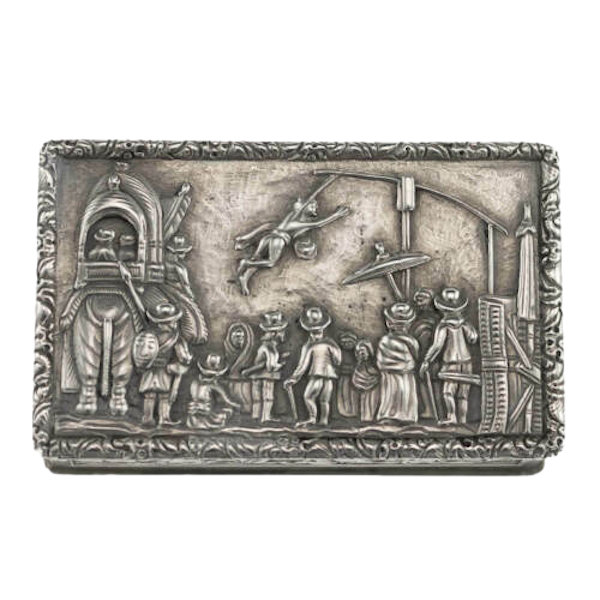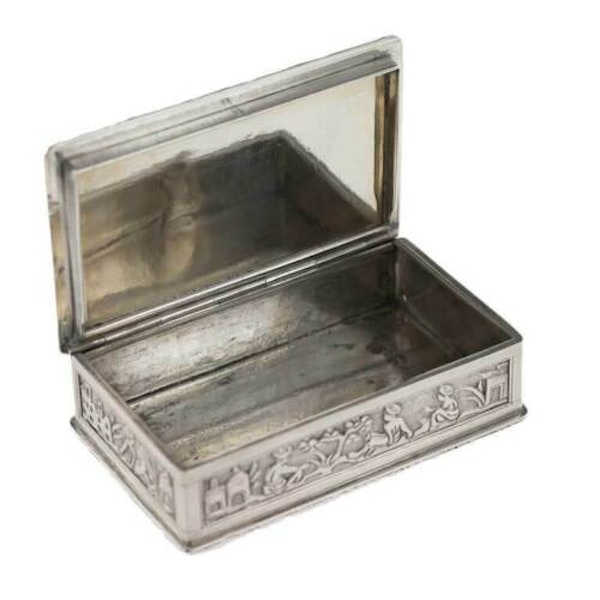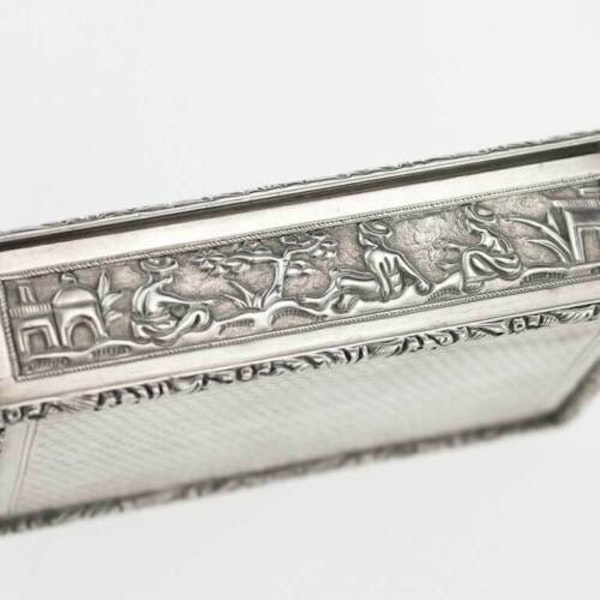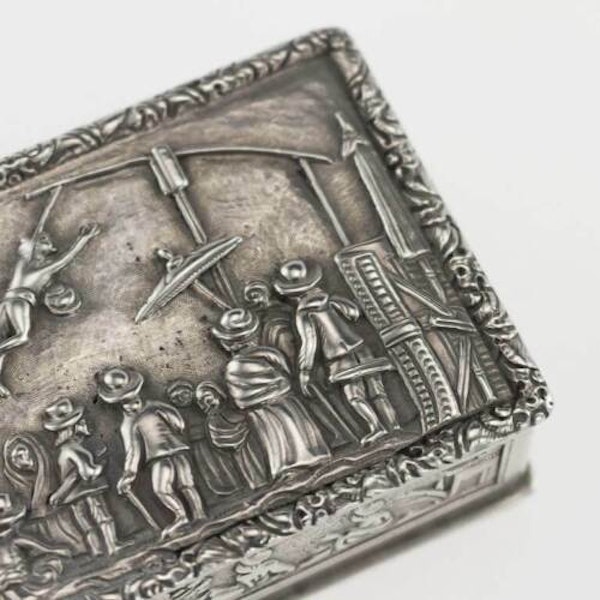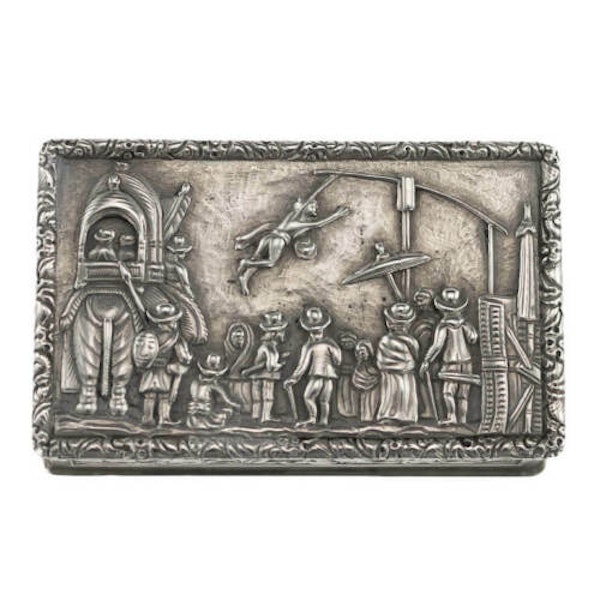Antique Indian Silver Snuff Box, Charak Puja/Hook Swinging, Calcutta – 1800/50
Antique Indian Silver Snuff Box, Charak Puja/Hook Swinging, Calcutta – 1800/50
£3,800.00
Description
This fascinating silver box was made for the Europeans visiting or living in India. Within raised floral and foliate borders, the scene on the lid depicts the ‘Charak Puja (also known as Nil Puja) Festival’, known by the English residents of Calcutta as‘The Hook Swinging Festival’. This colourful event was celebrated all over Bengal with much pomp and show on Chaitra Songkranti, the last day of the month Chaitra, and the eve of the Bengali New Year. The scene is after a drawing by Francois Baltazar Solvyns.
Solvyns was an artist who was born in Antwerp in 1760 and studied painting at the Antwerp Academy. In 1791, he came to India to seek his fortune as an artist but initially struggled to make an impact and subsisted by undertaking a range of part time jobs. Noting the British interest in the diverse and exuberant Indian culture, he soon became fascinated by the Indian culture and people himself and started to learn Hindu and Sanskrit. Encouraged by Sir William Jones, founder of the Royal Asiatic Society in Calcutta, he embarked on an ambitious project to produce "250 coloured etchings descriptive of the manners, customs, character, dress and religious customs of the Hindoos".
Being the first venture of its kind, Solvyns’ project brought in sufficient subscriptions to enable him to proceed with his plan. He recorded that his pictures of the Indian scene "would be particularly interesting to those who had resided many years in India, as a help to them, on their retreat to their native country to recall occurrences of their youth and scenes formerly familiar to them".
Solvyns work was pioneering and provides us with much historical information today. “He began drawing his subjects from life, which included men and women of every possible caste or calling ranging from high-caste Brahmins to milkwomen and sweepers. He portrayed many servants carrying out their specific duties within European households in Calcutta, such as a Sarkar, Hooka-bardar, Abdar etc. He also drew pictures of the colourful Indian festivals, ascetics and mendicants roaming about in the towns and villages, various forms of transport, including boats on the river, different kinds of pipes for smoking and a variety of musical instruments.” They were published in Calcutta in 1799, but the project was not a commercial success and he left India for France in 1804.
In Paris, he produced a folio edition of 188 plates with an accompanying descriptive text giving detailed information about the subject depicted in each text. ‘Les Hindous’ was published in Paris between 1808 and 1812 in four large volumes. Solvyns died in 1824.
One of the earliest and most vivid English accounts of the Charak Puja Festival was written by Fanny Parkes, a Welsh travel writer, who came to Kolkata in 1822 along with her husband, Charles Crawford Parkes, a writer for the East India Company:-
“The other day, hearing it was a Burra Din, (day of festival in honour of the goddess Kalee, whose temple is about a mile and half from Calcutta,) I drove down in the evening to Kalee Ghaut, where, had not the novelty of the scene excited my curiosity, disgust would have made me sick. Thousands of people were on the road, dressed in all their gayest attire, to do honour to the festival of the Chiiruk Pooja, the swinging by hooks. Amongst the crowd, the most remarkable objects were several Voiragee mendicants; their bodies were covered with ashes, their hair clotted with mud and twisted round their heads ; they were naked all but a shred of cloth. One man had held up both arms over his head until they had withered and were immoveable, the nails of the clenched fists had penetrated through the back of the hands, and came out on the other side like the claws of a bird. To fulfil some vow to Vishnoo this agony is endured, not as a penance for sin, but as an act of extraordinary merit. At first the pain must be great, but it ceases as the arms become benumbed. A man of this description is reckoned remarkably holy, having perfect dependence upon God for support, being unable, his arms having become immovable, to carry food to his mouth or assist himself. Two or three other mendicants who were present had only one withered arm raised above their heads. Some Hindoos of low caste, either for their sins or for money, had cut three or four gashes in the muscular part of the arm, and through these gashes they kept running a sword, dancing violently all the time to hideous music; others ran bamboos as thick as three fingers through the holes in the arm, dancing in the same manner. One man passed a spit up and down through the holes, another a dagger and a third had a skewer through his tongue.
A little further on were three swinging posts erected in this fashion; a post some thirty feet in height was crossed at the top by a horizontal bamboo, from one end of which a man was swinging, suspended by a rope, from the other end another rope was fastened to a horizontal pole below, which was turned by men running round like horses in a mill. The man swung in a circle of perhaps thirty feet diameter, supported by four iron hooks, two through the flesh of his back, and two in that of his chest, by which, and a small bit of cloth across the breast, he was entirely supported : he carried a bag in one hand, from which he threw sweetmeats and flowers to the populace below.
Some men swing with four hooks in the back and four on the chest without any cloth, eight hooks being considered sufficient to support the body. The man I saw swinging looked very wild, from the quantity of opium and bengh he had taken to deaden the sense of pain. Bengh is an intoxicating liquor, which is prepared with the leaves of the Ganja plant (Canabis Indica) .
Hindoos of the lower castes are very fond of this amusement, accidental deaths occasioned by it are reckoned about three percent. Sometimes four men swing together for half an hour ; some in penance for their own sins ; some for those of others, richer men, who reward their deputies and thus do penance by proxy.
Khraunchies full of nach girls were there in all their gaily-coloured dresses and ornaments, as well as a number of respectable men of good caste. I was much disgusted, but greatly interested. Sentries from the Calcutta militia were stationed round the swings to keep off the crowd.
The men on the mound at the foot of the second swing run round with the bamboo frame which is connected with the pole, at the summit of which are the cross bamboos. As they proceed, the four men above swing merrily on their hooks, scattering flowers and sweetmeats on the people, and repeating verses and portions of the shastrs. “
This unusual snuff box is stamped with the letter ‘P’, and dates between the years 1800 and 1850. One school of thought believes that these boxes were made in China for export to the Indian market whilst the other believes that they were actually made by Chinese silversmiths working in Calcutta. It is known that many fine Chinese craftsmen were working in Calcutta during the first half of the 19th century.
The principal panel on the lid illustrates a remarkable, if gruesome, ceremony which fascinated Europeans living in or visiting Calcutta. Fashioned using repousse and chased techniques, the depiction is after the drawing by French artist, Francois Solvyns. Around the sides of the box are figures dressed in an Indian style relaxing amongst trees and buildings which are once again in Indian style.
Provenance: UK art market
| item details | |
|---|---|
| Origin | Asian |
| Period | 19th Century |
| Style | Other |
| Condition | Excellent |
| Dimensions | Weight:106 grammes |
| Diameter | Height: 2 cms, Width: 7.5 cms, Depth:4.5 cms |
Product REF: 10040
